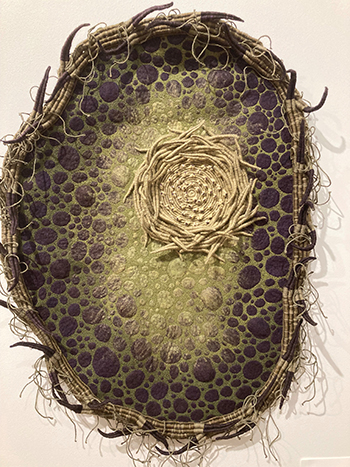Merino wool, yarn, beads, embroidery thread, wet felting, knotting, natural dyeing, free machine embroidery. Exhibited in Connection Point: Contemporary established fibre textile artists of ACT and NSW, Canberra Museum+Gallery.
It is no coincidence that Helen MacRitchie’s extraordinary creation closely resembles a human cell, although which one would be difficult to gauge. Her artist’s statement gives the game away: ‘Merino wool roving and yarn have been dyed green naturally with elder leaves and felted to depict a human cell. Boundary defences are wrapped and barbed to protect cellular contents and a nuclear nest.’
The artist goes on to explain that ‘The medieval Doctrine of Signatures [c 16th century, claiming that herbs resembling various parts of the body can be used by herbalists to treat ailments of those body parts] believed that the Elder tree treated many ailments because its fruit resembled the affected body parts.
‘This strange reasoning aside, pulmonary and cardiovascular systems do benefit from the antioxidants in elderberries helping to maintain our immune system.’
The assemblage, certainly of value to the viewer’s eye, was part of an accomplished group of works in the recent exhibition, Connection Point - Contemporary established fibre textile artists of ACT and NSW, in the national capital’s downtown Canberra Museum+Gallery.
The show highlighted fibre textile art, ranging from wall hangings to clothing, chosen from CMAG’s own collection, alongside works from ACT and NSW textile artists. Twenty artists from each territory/state were represented.
















